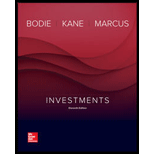
a.
To draw: A payoff graph depicting the strategy of given information.
Introduction:
Payoff graph: It is supposed to be a graphical representation of potential outcomes of a strategy. The vertical axis depicts the
b.
To draw: A profit graph depicting the strategy of given information.
Introduction:
Profit graph: It can also be called as risk graph. Profit graph is supposed to be visual depiction on possible outcomes of an options strategy on a graph. On the vertical axis, the profit/loss is depicted whereas the horizontal axis depicts the underlying stock price on expiration date.
c.
To analyze: Whether the portfolio has positive beta or negative when the underlying stock has positive beta.
Introduction:
Positive beta: Normally beta (ß) is used to measure the volatility of investment returns which are related to the whole market. When a stock values goes in the same direction in which the market prices are moving, it is said to be a positive beta.
Trending nowThis is a popular solution!

Chapter 20 Solutions
Investments
- Ends Mar 30 Discuss in detail, (Compare and Contrast), the various capital-budgeting tools explained in the chapter. (Payback period, Discounted Payback period, Net Present Value, Internal Rate of Return and Profitability Index). 0arrow_forwardEnds Mar 30 Discuss in detail what is Free Cash Flows and how is it calculated. Also define what is a Sunk Cost as well as an Opportunity Cost. 0arrow_forwardSubscribe Explain in detail what is a firm's Capital Structure? What is and how does a firm's Financial Policy impact its Capital Structure? Finally, what is opportunity costs and how does it affect a firm's Capital Structure?arrow_forward
 EBK CONTEMPORARY FINANCIAL MANAGEMENTFinanceISBN:9781337514835Author:MOYERPublisher:CENGAGE LEARNING - CONSIGNMENT
EBK CONTEMPORARY FINANCIAL MANAGEMENTFinanceISBN:9781337514835Author:MOYERPublisher:CENGAGE LEARNING - CONSIGNMENT Intermediate Financial Management (MindTap Course...FinanceISBN:9781337395083Author:Eugene F. Brigham, Phillip R. DavesPublisher:Cengage Learning
Intermediate Financial Management (MindTap Course...FinanceISBN:9781337395083Author:Eugene F. Brigham, Phillip R. DavesPublisher:Cengage Learning

